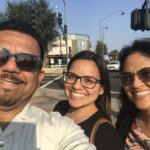
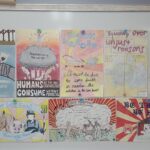
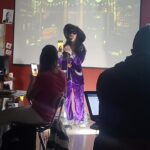
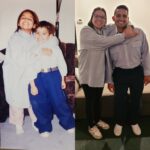

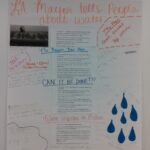
Author: Jasmine Quiñónez is an English I and Spanish I teacher at Purcell High School. In her nine years of teaching, she has taught ELL classes, English I, Honors English I, and Spanish I and II. This is also her second year of being an Academic Team coach.
One of the best things about being in the classroom is getting to work one-on-one with the kids and watching them learn and make real life connections with the work. This is not something that comes second nature to most. Having a very rambunctious and fidgety younger brother, I couldn’t help but grow up already trying to figure out how I would help him learn. And that question has never left me. Every lesson plan begins with “How can I get EVERY student engaged and help them learn?”. Seeing this question answered in real time, watching the kids grow in their understanding, makes this work worthwhile.
For example, my students have practiced the writing process through graffiti art on posters around the room, as opposed to the traditional pencil and paper process. Graffiti art posters have been our personal twist to a typical World Cafe or Socratic discussion activity. Students rotate in groups around the room and have different stations at which they have a prompt to discuss and respond with the classmates in their group. However, instead of simply discussing and taking notes students record their responses on the large Post-it posters at each station. Each student has their own marker and must record their personal response after discussing each prompt with the group. They are encouraged to use their own jargon and even use drawings to express their response (and penmanship is of no importance). By the time the activity is done, these once clean white posters on every wall of the room, are now covered in colorful words and drawings, or “graffiti”. Instead of brainstorming and expanding ideas on their own, they can freely discuss them with others. And instead of risking writers’ block by staring at a blank screen, they now have a jumping off point with which to begin, based not only on their responses but on the multiple available responses left on the posters by the class. This activity helps the students get excited about their topic, or the daily lesson, as they are actively involved and not just sitting listeners. Seeing them get excited about their work and starting an essay is something special. This fuels our already creative atmosphere and creates an environment where expression is not only allowed but welcomed. Students feel this.
Students have also participated in group and whole class discussions – listening to them form their own opinions and learn to defend and stand by their opinion is exciting. You are watching a student develop into an adult that has convictions and a voice. Although you want them to recognize and respect their parents and others’ opinions, you also want them to be their own individual and not just echos of someone else. Helping them find that voice is part of the job, and part of the reason why it’s such an important one. As difficult as things get, being with the students reminds you who it’s for, and why it’s all worth it.
One of my reasons for becoming an educator is that I wanted to see more people like me in the classroom. I wanted to be that Hispanic, Latina, Spanish-speaking English teacher. This is the minority representation I needed growing up. Being the daughter of a Puerto Rican mother and a Guatemalan immigrant father, I had a passion instilled in me early on to not only be a person of beliefs and unshakable convictions, but to also be an individual proud of my roots and be a good role model for my community. To now have students say I make them proud of their ethnicity, I make them want to be a better representative of minorities, and even learn more about our culture and community, makes it all worth it. If just ONE minority student is influenced to do something more with their life and for our Community, I will have done my job. It’s not just about helping them form convictions and use their voice for themselves, but for their family, culture, and community. I want students of all ethnic, social, and economical backgrounds to see that they can be the difference, that they can be the exception to any statistic stacked against them. Those numbers do not define us.
Although I want to make a change for all minority groups, I hope to not just influence young black and Hispanic students, but all students who come my way. Every award and grant worked for has been for them and their education, no matter who they are. I recently received the Marathon Oil Unconventional Thinking in Teaching award and grant. This honor helped shine a light on what is going on within the classroom and with my kids. It also helped fund so many more resources and hands-on lessons in the classroom, such as our graffiti posters activity, our Poetry Cafe Day, Mock Court, Toasts for Change, as well as help update supplies for so many units like our Poetry and Drama units. It helped with these and many other things, allowing me to continue this worthwhile work.
Answering the question “what made you want to be a teacher?” has always been difficult for me. As my parents can attest to, I have always wanted to be an educator. I do not remember a time where any other career was even in my thoughts. I have always said, “when God formed me, he formed a teacher”. This is what I was made to do. I don’t honestly know if I can put into words how much I LOVE what I do, how worthwhile and important it is. I want all my kids to find their calling in this world and find that same passion for a career that’s worth it for them.
This story was a part of the 2024 Spring edition of OEA’s Education Focus magazine.
